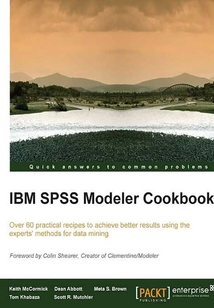舉報 

會員
IBM SPSS Modeler Cookbook
最新章節(jié):
Index
Thisisapracticalcookbookwithintermediate-advancedrecipesforSPSSModelerdataanalysts.Itisloadedwithstep-by-stepexamplesexplainingtheprocessfollowedbytheexperts.Ifyouhavehadsomehands-onexperiencewithIBMSPSSModelerandnowwanttogodeeperandtakemorecontroloveryourdataminingprocess,thisistheguideforyou.Itisidealforpractitionerswhowanttobreakintoadvancedanalytics.
目錄(93章)
倒序
- 封面
- 版權(quán)信息
- Credits
- Foreword
- About the Authors
- About the Reviewers
- www.PacktPub.com
- Preface
- Chapter 1. Data Understanding
- Introduction>
- Using an empty aggregate to evaluate sample size>
- Evaluating the need to sample from the initial data>
- Using CHAID stumps when interviewing an SME>
- Using a single cluster K-means as an alternative to anomaly detection>
- Using an @NULL multiple Derive to explore missing data>
- Creating an Outlier report to give to SMEs>
- Detecting potential model instability early using the Partition node and Feature Selection node>
- Chapter 2. Data Preparation – Select
- Introduction>
- Using the Feature Selection node creatively to remove or decapitate perfect predictors>
- Running a Statistics node on anti-join to evaluate the potential missing data>
- Evaluating the use of sampling for speed>
- Removing redundant variables using correlation matrices>
- Selecting variables using the CHAID Modeling node>
- Selecting variables using the Means node>
- Selecting variables using single-antecedent Association Rules>
- Chapter 3. Data Preparation – Clean
- Introduction>
- Binning scale variables to address missing data>
- Using a full data model/partial data model approach to address missing data>
- Imputing in-stream mean or median>
- Imputing missing values randomly from uniform or normal distributions>
- Using random imputation to match a variable's distribution>
- Searching for similar records using a Neural Network for inexact matching>
- Using neuro-fuzzy searching to find similar names>
- Producing longer Soundex codes>
- Chapter 4. Data Preparation – Construct
- Introduction>
- Building transformations with multiple Derive nodes>
- Calculating and comparing conversion rates>
- Grouping categorical values>
- Transforming high skew and kurtosis variables with a multiple Derive node>
- Creating flag variables for aggregation>
- Using Association Rules for interaction detection/feature creation>
- Creating time-aligned cohorts>
- Chapter 5. Data Preparation – Integrate and Format
- Introduction>
- Speeding up merge with caching and optimization settings>
- Merging a lookup table>
- Shuffle-down (nonstandard aggregation)>
- Cartesian product merge using key-less merge by key>
- Multiplying out using Cartesian product merge user source and derive dummy>
- Changing large numbers of variable names without scripting>
- Parsing nonstandard dates>
- Parsing and performing a conversion on a complex stream>
- Sequence processing>
- Chapter 6. Selecting and Building a Model
- Introduction>
- Evaluating balancing with Auto Classifier>
- Building models with and without outliers>
- Using Neural Network for Feature Selection>
- Creating a bootstrap sample>
- Creating bagged logistic regression models>
- Using KNN to match similar cases>
- Using Auto Classifier to tune models>
- Next-Best-Offer for large datasets>
- Chapter 7. Modeling – Assessment Evaluation Deployment and Monitoring
- Introduction>
- How (and why) to validate as well as test>
- Using classification trees to explore the predictions of a Neural Network>
- Correcting a confusion matrix for an imbalanced target variable by incorporating priors>
- Using aggregate to write cluster centers to Excel for conditional formatting>
- Creating a classification tree financial summary using aggregate and an Excel Export node>
- Reformatting data for reporting with a Transpose node>
- Changing formatting of fields in a Table node>
- Combining generated filters>
- Chapter 8. CLEM Scripting
- Introduction>
- Building iterative Neural Network forecasts>
- Quantifying variable importance with Monte Carlo simulation>
- Implementing champion/challenger model management>
- Detecting outliers with the jackknife method>
- Optimizing K-means cluster solutions>
- Automating time series forecasts>
- Automating HTML reports and graphs>
- Rolling your own modeling algorithm – Weibull analysis>
- Appendix A. Business Understanding
- Introduction>
- Define business objectives by Tom Khabaza>
- Assessing the situation by Meta Brown>
- Translating your business objective into a data mining objective by Dean Abbott>
- Produce a project plan – ensuring a realistic timeline by Keith McCormick>
- Index 更新時間:2021-07-23 16:01:53
推薦閱讀
- 中國國民經(jīng)濟核算體系修訂問題研究
- 新形勢下中國投入產(chǎn)出核算的變革與實踐
- 審計學基礎(chǔ)
- 金融保險集團內(nèi)部審計創(chuàng)新與實踐
- Mastering System Center Configuration Manager
- 會計信息化基礎(chǔ)(金蝶版)
- 審計綜合模擬實訓
- EViews10.0的應(yīng)用與計量分析
- 基本有用的計量經(jīng)濟學
- AO2011實用手冊
- 從零開始學房地產(chǎn)會計
- 成功通過PMP(第3版)
- Tableau:Creating Interactive Data Visualizations
- Minitab Cookbook
- 下一場全球金融危機的到來:明斯基與金融不穩(wěn)定
- 2017年度注冊會計師全國統(tǒng)一考試專用教材(圖解版):審計
- Implementing VMware Horizon 7.7
- 計量經(jīng)濟學
- 財務(wù)會計習題集
- Instant Windows PowerShell Guide
- 房產(chǎn)稅征收對區(qū)域經(jīng)濟的影響:以新都區(qū)為例
- Microsoft Dynamics AX 2012 R2 Services
- 數(shù)量經(jīng)濟研究(2019年第10卷/第3期)
- Mastering Parallel Programming with R
- Microsoft Dynamics GP 2013 Financial Management
- 會計崗位實訓(第2版)
- 審計理論與實務(wù)(第2版)
- 趣學貝葉斯統(tǒng)計:橡皮鴨、樂高和星球大戰(zhàn)中的統(tǒng)計學
- 國民經(jīng)濟核算理論與中國實踐
- Microsoft Dynamics AX 2012 Reporting Cookbook

